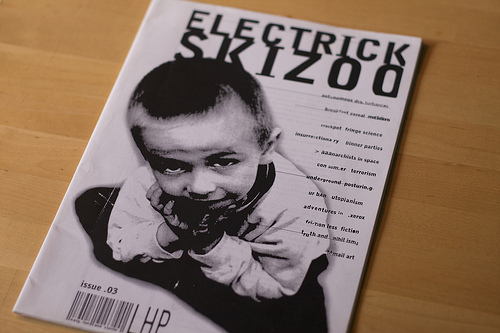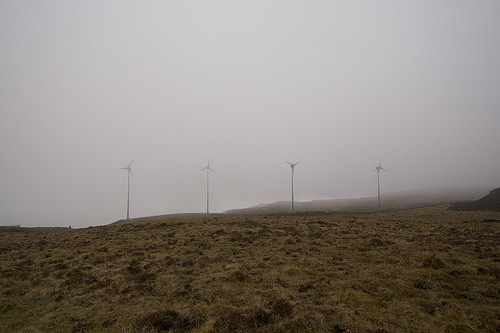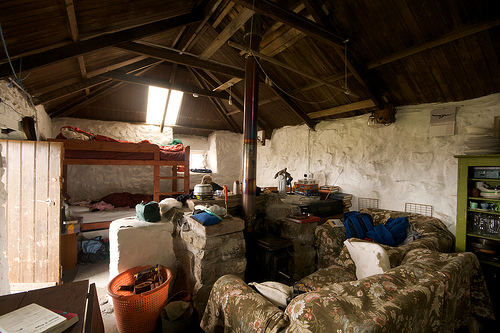Beginnings
Post number 1. A shiny new domain name, fresh hosting, a clean install of WordPress. You only get one first post, so it seems appropriate to use it to talk about beginnings.
It must have been around about 1992. Inspired by a thriving underground music scene, a casual brush with radical politics, access to technology and too much time, my friend Tim and I started our own fanzine, called Electrick Skizoo.
I had a copy of Quark XPress and free printing in the university library so I set about learning how to use a Mac and DTP software. Electrick Skizoo lasted for 3 issues on an irregular publishing schedule, and we struggled to distribute it through alternative bookshops, at clubs, gigs and through the ever helpful and optimistic AK Press, the main pipeline of anarchist and underground literature into the UK. They gave us a mail drop and agreed to sell our zine along with many other far more successful publications like Boing Boing (then a paper publication) and Vague.
I had a few opportunities to step out from behind the computer. We hitched down to the University of Warwick in ’95 to attend the Virtual Futures philosophy unconference. We hawked copies of the zine to anyone who would pay attention; we also spotted Hakim Bey – one of my heroes at the time – kipping on the couch (the sleeping arrangements were very much ‘every man for himself’). I also went down with AK to the Anarchist Bookfair at Conway Hall in London, manned a book stall and flogged many copies of other people’s zines.
The lack of either distribution or groupies eventually led to Skizoo’s demise after a couple of years. At the same time, the internet was becoming more accessible and I started to discover a whole new world of Bulletin Boards (BBSs) Gopher, FTP, Usenet, and eventually, thanks to Mosaic (the predecessor of Netscape), the Web.
I soon stumbled on the equally ill-named Spunk Press (“spunk” meaning in Swedish, “anything we want it to mean”) an online archive of anarchist and alternative literature. (Now defunct, but some content is still available on the Wayback Machine.) I got involved in the edges of the group, scanning in books, distributing flyers and so on, but mostly feeding off the energy created by this exciting, purposeful, and slightly dangerous-sounding community. One of the founders of Spunk Press, Ian Heavens, was based in Edinburgh, where I was living, and we met up to discuss anarchism and samba, one of his other passions. Ian was kind and generous, and a very smart guy, responsible for some sort of highly clever work on internet infrastructure like HTTP or IPv6.
Anyway, time passed; I drifted away from Spunk Press and eventually moved to Brighton. My politics and taste in music softened. Many years later, I was thinking back to these times and googled Ian’s name to see what he was up to. I was shocked to find that he had died. There was a memorial page with comments posted by friends he had made all over the world.
This discovery, amplified by distance and time, marked the end of a chapter of my life. I started to think about those events, adventures and people in a different light. I never set out to do those things in order to learn, but along the way I did, as we all do. Many of the lessons are only becoming clearer with the perspective of time.
The contrast between our isolated work on the fanzine; the constant struggle we had to reach an audience and the energy and effectiveness of the Spunk Press community was vivid. Spunk Press was a shared platform that fed energy back to its contributors and could adapt as individuals came and went. The power of events like Virtual Futures or the Bookfair to bring together like-minded people and energise them was even greater. Doubly so because these were marginal groups who didn’t have a voice in mainstream culture. Even the AK office, with its piles of books coming and going, was a hub in a global network, and that gave it a creative energy.
This can all be applied to the work we do now. When you’re looking to broadcast a message, consider instead how you can collaborate. One person shouting is no match for many people working together.
Communities, shared collective platforms are powerful engines of creativity and innovation. The technology can be primitive if the common intent is strong. And the effectiveness of networked communities can be amplified when you bring them together into a shared physical space.
Two current examples, both relating to climate change, an issue desperately in need of innovation, creativity and collective action. For the past couple of years I’ve been working on a well-known national climate change campaign. We’ve struggled with top-down communication, whether it was through TV, cinema, press or online. There has been a hostile audience fed by a media eager to stir up fear and uncertainty. And even in the best possible conditions, people rarely react well to messages telling them what they ought to do. It started to get interesting when we went out and engaged with local communities who were taking action on climate change. We listened instead of talking. And we gave them a platform to share their experiences and inspire others. We witnessed a depth of engagement and an appetite for change far greater than anything we had seen through our other activities.
The second example is that of a community occupying one physical space – the island of Eigg off the west coast of Scotland. Eigg has suffered from a history of careless and uninterested absentee landlords. In 1997, the community (with the help of Scottish Wildlife Trust and the Highland Council) managed to buy the island for themselves and so started on a project of regeneration and local enterprise. One of the projects is a self-sufficient local energy grid, powered largely by renewable sources (wind, solar and hydro). Houses on the island have energy meters installed and local residents are capped on their energy usage. As well as generating their own power, the islanders have begun to tackle the challenges of energy efficiency, reliance on fossil fuels, transport and waste.
I went to Eigg in 2008 and stayed in one of these houses. I visited the wind and solar installations and spoke to many residents about the project. While there were clearly many challenges to be overcome, I was struck by how engaged, energised and focused people were. They were brought together by a shared endeavour and were eager to spread the word beyond the limits of the island.
These projects show what can be done when you build a shared platform, when you gather a tribe. They may carry you to places you would never have imagined going on your own.


